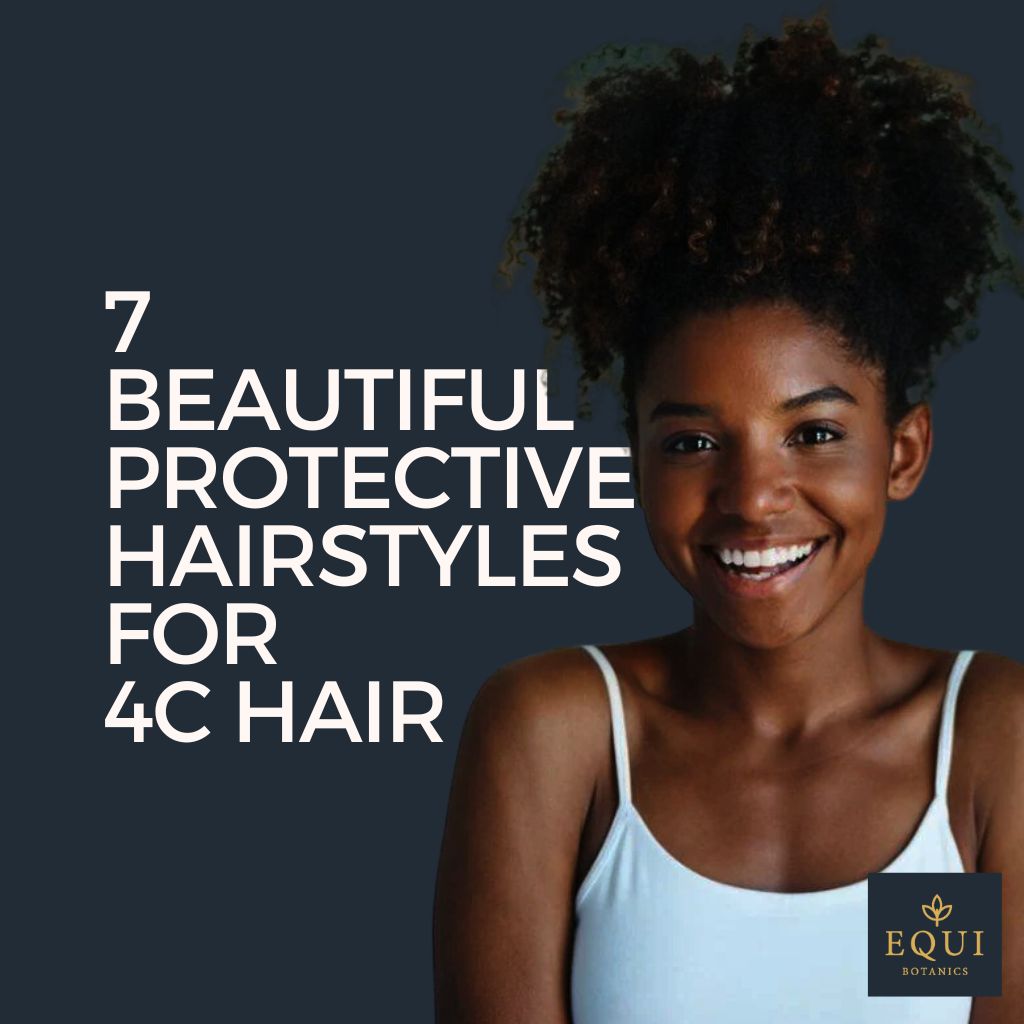
4C hair is known for its tight coils and delicate nature, making it prone to occasional damage and breakage, which can of course be stressful. However, by using certain hairstyles you can help protect the hair from damage, maintain moisture and promote hair growth. So don’t panic, we’ve got 7 beautiful protective hairstyles for 4C hair that will help keep your hair healthy and stylish. Keep reading to find out more!
4C Protective Styles | Our Top 3
1. Best for Hair Loss | Bantu Knots |
2. Best for Classic Style | Braids |
3. Best for Ultimate Protection | Wigs |
 |
 |
 |
How to Choose the Best Protective Styles for 4C Hair
When it comes to choosing the best protective hairstyles for 4C hair, it's important to consider your hair’s texture and thickness. Hairstyles like braids, twists and updos can help protect your hair from damage and promote hair growth.
Take into consideration your personal style and lifestyle when choosing a hairstyle. If you prefer low-maintenance styles that you can wear for a longer period, you may want to consider braids or twists. If you want more versatility and the ability to change your hairstyle frequently, then wigs or weaves may be a good option.
How Does 4C Hair Differ from Other Hair Types?

4C hair has tight coils with small or no visible curl definition that is often identifiable by its zig-zag pattern as each coil forms a sharp angle.
Unlike other hair types, such as 3C, which have looser curls, 4C hair is more prone to dryness and shrinkage and because of its tight could it can be prone to more tangles and difficult to style.
With proper care and styling techniques, 4C hair can be healthy and beautiful but it is important to get to grips with your hair type and to understand its characteristics, to keep it well maintained.
How Do You Prepare 4C Hair for Protective Styling?
Preparing 4C hair for protective styles involves several steps. You will firstly want to ensure that your hair is both clean and moisturised. Use a shampoo such as the Baobab Detangler and Cleanser to remove build up and nourish the locks. You may also want to use a leave-in conditioner, such as the Marula Leave In Conditioner, or oil with a potent ingredient such as Black Seed Oil, to keep your hair nice and hydrated.
Use a detangling brush to work any knots out of the hair, starting at the ends and working up to the roots to minimise damage and make it easier to style. Finally, consider using a protective product, such as a heat protectant, to further protect your hair from damage. Following these steps will help to keep your 4C hair not only healthy, but also ready for your protective style of choice.
7 Protective Hairstyles for 4C Hair
1. Braids

The most likely stress-related hair loss is telogen effluvium. This condition sees the hair follicles pushed into the resting phase of the hair cycle. In a normal hair cycle, around 90% of the follicles are in the growth phase with the remaining in the rest stage. When there’s an increase of follicles in the resting phase, there will be a substantial rise in hair shedding that can lead to an obvious and generalised thinning.
Pros:
- Classic style
- Easy maintenance
- Long-lasting
Cons:
- Can be itchy
- May cause scalp irritation
- Can be time-consuming to install
Pro Styling Tip:
Keep your scalp moisturised by using a light oil or rice water hair mist, such as the Rice Water & Green Tea Hair Tonic. This can help prevent dryness and irritation.
Rice Water and Green Tea Hair Tonic and Detangler
The Rice Water and Green Tea Hair tonic is jam-packed with natural, detangling and hydrating botanicals for refreshing hair daily. It is very effective on gym days when the hair is dried out from sweat so you can feel confident after a workout. The Rice Water and Green Tea hair tonic is also effective when used for detangling hair on wash days to save hours before applying the cleanser.
2. Faux Locs

Faux locs are a trendy protective hairstyle that can give you the appearance of having dreadlocks without the commitment. They’re made by wrapping extensions around your natural hair and can be styled in various lengths and thicknesses.
Pro Styling Tip:
Use a leave-in conditioner or oil to keep your scalp and hair moisturised while wearing faux locs. What does this achieve? A prevention of breakage and promotion of healthy hair growth.
Pros:
- Trendy style
- Can be styled in various lengths and thicknesses
- Low maintenance
- Protects natural hair
Cons:
- Can be heavy
- May cause discomfort
- Can take a long time to install
3. Twists

Twists are another popular protective hairstyle for 4C hair. They can be done using your natural hair or with extensions and can be styled in various sizes and lengths. Twists are easy to maintain and can last for weeks.
Pro Styling Tip:
Try using a gel or cream to help define your twists and reduce frizz as this will help your twists last longer and look more polished.
Pros:
- Popular styles
- Versatile sizes and lengths
- Easy to maintain
Cons:
- Can be itchy
- May cause scalp irritation
- May unravel if not properly maintained
4. Bantu Knots

This protective hairstyle involves sectioning your hair into small sections, twisting them, and then wrapping them into small buns. The reason bantu knots offer such a good protective style for 4C hair is because they help to stretch your curls and promote hair growth.
Pro Styling Tip:
Apply a leave-in conditioner or oil to your hair before twisting it into Bantu knots to nourish the locks and reduce the risk of breakage.
Pros:
- Stretch curls
- Promotes hair growth
- Easy style
Cons:
- Hard to sleep in
- Takes a long time to do
- Can be uncomfortable
5. Protective Updos

Protective updos are a versatile hairstyle that can be worn for any occasion. They involve pulling your hair up into a bun or other style that tucks away your ends and protects your hair from damage.
Pro Styling Tip:
Use a hair tie or pins to secure your updo and try not to pull your hair too tightly to avoid tension headaches and hair damage.
Pros:
- Versatile
- Can be worn for any occasion
- Protects from damage
Cons:
- Needs additional styling products
- This isn’t a great protective style for short natural hair
6. Halo Braids

Halo braids are a protective hairstyle that involves braiding the hair around the perimeter of the head, creating a crown-like effect. They are a great protective style for 4C hair because they keep the hair off the face and protect the ends from damage.
Pro Styling Tip:
Apply cream to help smooth down any flyaways or frizz for a neater finish.
Pros:
- Gorgeous crown-like look
- Protects ends
- Keeps hair off face
Cons:
- May require a lot of hair extensions
- Hard to do without help
- Won’t work for all hair lengths
7. Wigs

Wigs are a popular protective style that can be used to protect your natural hair while giving you the ability to switch up your look. They come in various styles and textures and can be easily styled to your liking.
Pro Styling Tip:
Use a wig cap to protect your hair and help your wig stay in place.
Pros:
- Protects natural hair
- Various style and texture
- Can be easily styled to your liking
- A quick and easy protective style for 4C hair
Cons:
- Might not look natural
- Can be uncomfortable and require frequent adjustments
- Expensive
Are there Other Ways to Protect 4C Hair that Don’t Involve Hairstyles?
As well as using protective hairstyles to minimise damage to your 4C hair, you could also consider using the following:
- Satin or silk pillowcases: Using a satin or silk pillowcase is beneficial as it can help reduce friction and prevent breakage while you sleep.
- Protective headwear: Wearing a satin or silk scarf, bonnet or hat like a pillowcase will reduce friction to lessen frizz, but can also protect your hair from environmental damage.
- Regular trims: Getting regular trims can help prevent split ends and breakages which can lead to hair damage.
- Deep conditioning treatments: Deep conditioning treatments can help nourish and strengthen hair, reducing the risk of breakage.
- Low manipulation styling: Choosing hairstyles that don't require a lot of manipulation, such as wash-and-go styles, can also contribute to less severe hair damage.
- Proper nutrition: Eating a balanced diet; that’s to say, one that’s plentiful in minerals, proteins and vitamins can help prevent breakage and damage, as well as support healthy hair growth.
Are there Any Hairstyles that You Should Avoid for 4C Hair?
There are certain hairstyles and techniques that women with 4C hair may want to avoid in order to minimise the risk of hair breakage as well as damage to the scalp. These include:
- Tight ponytails or buns: Hairstyles that pull your hair tightly can cause tension headaches, hair damage, and even hair loss over time.
- Heat styling: Using specialist heat tools, such as curling or flat irons, can cause heat damage and breakage, especially if you don't use heat protectant products.
- Chemical treatments: Chemical treatments, such as relaxers or perms, can weaken and damage 4C hair over time, leading to breakage and hair loss.
- Heavy extensions: Adding heavy extensions to your hair can cause tension and stress on your natural hair, which will cause snapping as well as loss.
- Over-brushing or over-combing: Brushing or combing your hair too frequently or too aggressively can cause breakage and damage, especially if your hair is already dry or brittle.
Summary
Protective hairstyles are an excellent way to keep your 4C hair healthy and promote hair growth and reduce hair loss and damaged locks, which can feel stressful. Whether you prefer braids, twists, updos, or wigs, there are many options to choose from.
Remember to moisturise your hair regularly and take care of your edges to maintain the health of your hair. By following these tips and trying out some of the protective hairstyles mentioned above, you can keep your hair looking both beautiful and healthy.


